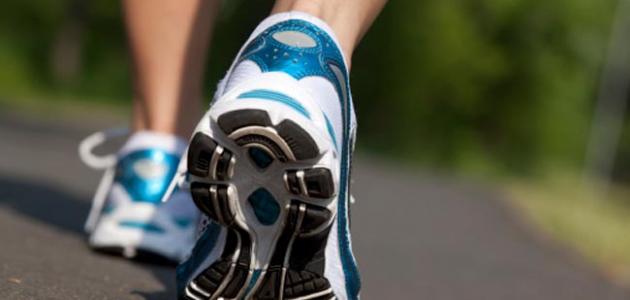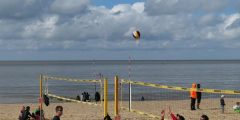Walking and burning calories
Any type of physical activity requires energy consumption, and the greater the level of effort required by physical activity, the more calories the body burns, so fast walking burns more calories than moderate walking, and the degree of surface elevation affects the burning of calories, for example For example, if walking uphill and quickly at a speed of 8 kilometers per hour, the body can burn more than 7 calories per minute, but if walking downhill and slowly at a rate of 5 to 6 kilometers per hour, the body can burn between 3.5 and 7 calories. per minute.
It is worth noting that the amount of calories the body burns during walking depends on the distance traveled, and the body weight in particular, and genes can also have an effect on this.
The number of calories that can be burned by walking
The following table shows the number of calories the body burns based on its weight and the intensity of steps when walking on a flat surface for a full hour:
| Weight (kg) | Number of calories burned at a speed of 3.2 km/hour (kcal) | Number of calories burned at a speed of 4.8 km/hour (kcal) | Number of calories burned at a speed of 6.4 km/hour (kcal) | Number of calories burned at a speed of 8 km/hour (kcal) |
|---|---|---|---|---|
| 59 | 173 | 266 | 309 | 514 |
| 73 | 214 | 329 | 383 | 636 |
| 86 | 253 | 388 | 451 | 749 |
| 100 | 294 | 451 | 525 | 872 |
If you climb stairs, or high places such as hills, or use a treadmill, this will lead to burning more calories and increasing the intensity of the exercise. The following table shows the number of calories that the body burns when walking at a rate of 5.6 kilometers per hour on flat surfaces such as sidewalks and walking. Up which increases the burn rate significantly:
Read also:What are the rules of handball?| Weight (kg) | Number of calories burned when walking on a flat surface (calories) | Number of calories burned when walking uphill (calories) |
|---|---|---|
| 59 | 224 | 354 |
| 70 | 267 | 422 |
| 81.6 | 311 | 490 |
| 93 | 354 | 558 |
Calculate the calories you burn while walking
The number of calories that the body burns during any physical activity depends on the basal metabolic rate and the intensity of the activity, which is usually measured by the metabolic equivalent of task. This equation can be used to calculate the number of calories that The body burns them while walking, and they are as follows:
- Calories burned by the body = Basal Metabolic Rate x Metabolic Equivalent ÷ (24 x Duration of Activity in Hours)
As for the basal metabolic rate, it refers to the calories that the body burns during a series of processes that the body constantly performs to stay alive, such as breathing. This rate varies between people, and it is difficult to calculate accurately, as it depends on many factors, including genetic factors that It is difficult to measure, but the basal metabolic rate can be estimated depending on gender, weight, and age through the following equations:
Read also:Mountain climbing exercise- Basal metabolic rate for females = 655 + (x 9.6 weight (kg)) + (x 1.8 height (centimetres)) – (x 4.7 age (years))
- Basal metabolic rate for males = 66 + (x 13.7 weight (kg)) + (x 5 height (centimetres)) – (x 6.8 age (years))
As for the metabolic equivalent, it is a measure of the amount of energy that the body expends for a specific activity. In the case of walking, the walking speed will determine the amount of the metabolic equivalent. If the walking is at a slow speed at a rate of 2.7 kilometers per hour, then the metabolic equivalent is equal to 2.3 per hour, while fast walking is at a speed of 4.8 kilometers. Per hour, the metabolic equivalent is 3.3 per hour.
By calculating the previous two factors, it is possible to calculate the number of calories that the body burns while walking. For example: a 88.4-year-old adult man, weighing 175 kilograms, and 1881.76 centimeters tall, his basal metabolic rate is equal to 3.3, and in the case of walking at a fast pace, the metabolic equivalent is equal to XNUMX If you walk for one hour, the number of calories the body burns is equal to:
- Basal metabolic rate (1881.76) x metabolic equivalent (3.3) ÷ 24 x duration of activity in hours (1) = 258.7 calories.
Tips to increase calorie burning through walking
Here are some tips that can be followed to increase the burning of calories while walking:
Read also:What is judo?- Walking fast: The pace of walking makes a big difference. A person can burn more calories while walking at a fast pace than when walking slowly.
- Wearing a heavy jacket while walking, which stimulates the body to work harder while walking, so adding additional weight to exercises burns more calories.
- Walking uphill. This can be done by increasing the gradient on the treadmill, or climbing hills and high places in your outdoor walking routine.
- Try adding resistance exercises while walking to help burn more calories and increase muscle growth, such as: push-ups, squats, or so-called squats.
- Focus on the walking position, as walking while looking forward all the time helps increase walking speed and step size. It is also recommended to focus on tightening the abdominal muscles and the gluteal muscles in the buttocks (in English: Glutes), as this can be done throughout the walking period, or For multiple and short periods.
- Add periods during walking, and start with short periods, where you can start with a slow warm-up for 10 minutes, then increase the speed and walk at a harder pace for 15 to 20 seconds at the beginning of each minute, in order to raise the heart rate and burn more calories, and continue doing so for 10 minutes. minutes, then finish with ten minutes of quiet and slow walking, and the time of fast walking in the intervals can be increased gradually.
- Increasing the number of steps in daily routines and tasks, such as: queuing up away from home, climbing stairs, and others.
An overview of walking
Walking is one of the simplest exercises that is usually underestimated. Anyone at any age, with all levels of physical fitness, can practice walking. This type of sport is also considered one of the physical activities suitable for overweight people, the elderly, or people Those who have not exercised for a long time, as walking is one of the low-impact exercises that requires minimal equipment, and can be done at any time of the day. Walking regularly can help maintain a healthy weight, increase bone and muscle strength, and improve the mood.









